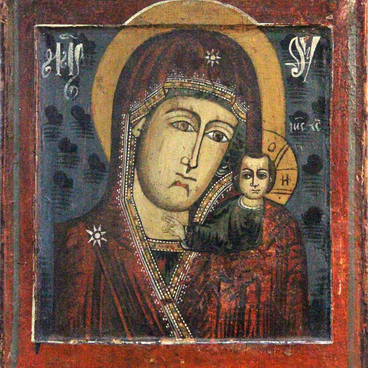The Virgin of Smolensk image belongs to Hodegetria type. This name originated from the name of an ancient Christian temple Odegon in Greece, where the first icon of this type was found. The author of the book about the lives of saints Hagiography Dmitry Rostovsky believed that the very first Hodegetria was painted by Luca the Evangelist on the commission by bishop Theophilus of Antioch.
The Virgin Hodegetria of Smolensk
Время создания
Second half of the 16th century
Размер
116,1x93,2 cm
116.1х93.2х3.1 cm
116.1х93.2х3.1 cm
Техника
Wood, tempera
0
Открыть в приложении#1

Unknown author
The Virgin Hodegetria of Smolensk
#2
#8
The specialists are uncertain about the way the icon first got to the cities of Russia. According to one of the versions, princess Anne of Chernigov brought it from Byzantine in 1046. Early in the 12th century, the grand prince Vladimir Monomakh ordered to bring the icon from Chernigov to Smolensk and erect the church of the Dormition of the Theotokos there. The icon was called ‘of Smolensk’ since then.
#7
Iconography
#4
The Virgin Hodegetria of Smolensk, Moscow, 1456. Source: wikipedia.org
The Virgin was usually painted waist-deep on the icon of Smolensk. With her right hand she pointed to the Christ child holding in his left hand a scroll of the Law of the Lord and raising his right hand in a blessing gesture.
#5
In those years, our ancestors created icons in several stages. First, they dried the wood, then split the logs and cut wooden bases of future icons. They used non-torch wood: lime, alder, imported cypress, but sometimes also softwood. Usually, specialized craftsmen prepared the boards for future icons, they were called levkas coaters. They glued special linen fabric on the face side of the board. On the next stage they covered this fabric with several layers of levkas — a special chalk solution. When levkas dried, it was polished with stems of horsetail grass, and then the iconographers painted images with tempera. This paint consisted of powder pigment and egg yolk, later they started adding boiled flaxseed oil or lacquer. Sometimes icons were covered with gold leaf. Such covers would often close not just the frame, but the background between the main figures.
#6
The icon of The Virgin Hodegetria of Smolensk from the collection of Khanty-Mansiysk State Museum of Fine Arts was painted in the second half of the 16th century. It was kept in different churches of the Volga River region for several ages. The Generations Fund of Khanty-Mansiysk Autonomous District acquired it at the end of the 20th century, and in 2011, it passed the icon to the museum collection.
#9
State Museum of Fine Arts of Khanty-Mansiysk
читать дальшескрыть
00:00
00:00
1x
The Virgin Hodegetria of Smolensk
Время создания
Second half of the 16th century
Размер
116,1x93,2 cm
116.1х93.2х3.1 cm
116.1х93.2х3.1 cm
Техника
Wood, tempera
0
Открыть в приложении
Поделиться


